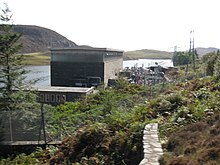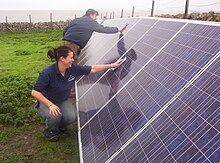User:Llywelyn2000/sandbox
Renewable energy in Wales

In 2018, Wales reached the milestone of 50% of its electricity consumption being generated by renewable electricity: up from 19% in 2014. The Welsh Government has set a target of 70% by 2030.[1] In 2019 Wales was the world’s 5th largest exporter of electricity (22.7 TWh), mainly to Ireland and England.[2][3] The natural resource base for renewable energy is high by European standards, with the core sources being wind, wave, and tide. Wales has a long history of renewable energy: from the 1880's first house in North Wales with electric lighting powered from its own hydro-electric station (Plas Tan y Bwlch), the 1963 large scale generation of hydroelectricity at Llyn Stwlan plant to the opening of the Centre for Alternative Technology at Machynlleth in November 1973.
In April 2019, the Welsh Government declared a Climate Emergency,[4] followed on 1 May by the Senedd becoming the first parliament in the world to pass a Climate Emergency resolution.[5]
Government policy[edit]
Increasing the percentage of renewable energy in Wales is Government policy; as part of this, projects such as Prosperity for All: A Low Carbon Wales were launched. Crucially, the Welsh Government expect all new energy projects to include an element of local ownership. It is estimated that 825 MW of installed renewable energy capacity was locally owned in 2019.[6] 'Prosperity for All' was the Government's approach to cut emissions and increase efficiency in order to maximises wider benefits for Wales. It sets out 100 policies and proposals that directly reduce emissions in order to support the growth of the low carbon economy. Since the passing of the Environment (Wales) Act, the Government has been guided by the Well-Being of Future Generations Act to face the challenge of climate change.[7]
2019 also saw the first electricity being generated by the the second largest onshore wind farm in Wales, the 27-turbine wind farm at Clocaenog Forest, on the Welsh Government woodland estate.
In 2016 the low carbon economy was estimated to consist of 9,000 businesses, employing 13,000 people and generating a £2.4 billion turnover.[6]
By local authority area[edit]
Equivalent percentage of electricity consumption delivered by local renewable generation in 2019:
- Ceredigion: 110%
- Denbighshire: 100%
- Powys: 91%
- Rhondda Cynon Taf: 66%
- Neath Port Talbot: 65%
Electricity generation[edit]
In 2019 Wales was a net exporter of electricity, having consumed approximately 14.7 TWh of electricity in 2019, while generating approximately 27.9 TWh. this means that it exports twice as much electricity than it uses. Over 27% of electricity generation in Wales is from renewables, with much of the rest generated by gas.[7] Aberthaw power station was the last operational coal-fired power station in Wales, closing in March 2020. Currently (2021) here are no nuclear power stations currently operating in Wales. In 2019, there were 56,860 renewable electricity projects in Wales, 1,076.[6]
Hydropower[edit]


List of hydropower stations:
| Name | Location | Coordinates | Output | Notes |
|---|---|---|---|---|
| Cwm Dyli hydro power station[8] | Gwynedd | 10 MW | commissioned 1906 operational | |
| Dinorwig Power Station | Gwynedd | 53°7′7″N 4°6′50″W / 53.11861°N 4.11389°W | 1728 MW | (pumped storage) |
| Dolgarrog power station | Conwy (county borough) | 53°11'28"N 3°50'33"W | 28 MW | commissioned 1907 operational 2020 |
| Dolgelley power station | Dolgellau | 148 kW | hydro + oil engine | |
| Ffestiniog Power Station | Gwynedd | 52°58′51″N 3°58′8″W / 52.98083°N 3.96889°W | 360 MW | (pumped storage) |
| Machynlleth A power station | Powys | 250 kW | hydro + oil engine[8] | |
| Maentwrog power station[8] | Gwynedd | 52°56'10"N 4°00'15"W | 30 MW | commissioned 1928, refitted 1988-92 |
| Rheidol Power Station | Ceredigion | 52°23′46″N 3°54′00″W / 52.39611°N 3.90000°W | 49 MW | |
| River Tawe Barrage | Swansea | 51°36′58″N 3°55′44″W / 51.61611°N 3.92889°W | ||
| Towyn power station[8] | Tywyn | 950 kW | hydro + oil engine | |
| Radyr Hydro Scheme | Cardiff | 51°31'9.79"N 3°15'13.50"W | 394 kW | Hydro (River Weir Screw Turbines) |
In 2019 there were 363 hydropower projects in Wales, with the capacity of 182MW; over 347 GWh is generated annually. Half of the total is generated by the three largest projects.[7]: 17 Gwynedd has the greatest number of hydropower projects (144 in 2019). Wales’ largest hydropower project is Rheidol Power Station, Ceredigion, which has the greatest hydropower capacity: just under 71 MW across 26 projects. Rheidol Power Station was commissioned in 1964 and has a capacity of approximately 56 MW.[9]
Wind power[edit]
| Name | Location | Coordinates | Output | Notes |
|---|---|---|---|---|
| Alltwalis Wind Farm[8] | Carmarthenshire | 51°58′24″N 4°15′3″W / 51.97333°N 4.25083°W | 23 MW | |
| Brechfa Forest Wind Farm | Gwernogle, Carmarthenshire | 90 MW | ||
| Carno wind farm | Carno, Powys, Mid Wales | 52°33′1″N 3°36′1″W / 52.55028°N 3.60028°W | 49 MW | |
| Cefn Croes wind farm | Ceredigion | 52°24′18″N 3°45′03″W / 52.40500°N 3.75083°W | 58.5 MW | |
| Moel Maelogen | Conwy | 53°08′07″N 3°43′25″W / 53.13528°N 3.72361°W | 14.3 MW | |
| North Hoyle Offshore Wind Farm | Liverpool Bay | 53°26′N 3°24′W / 53.433°N 3.400°W | 60 MW | |
| Pen y Cymoedd | Neath | 51°41′01″N 03°41′01″W / 51.68361°N 3.68361°W | 228 MW | |
| Rhyd-y-Groes | Anglesey | 7 MW | ||
| Rhyl Flats | Liverpool Bay | 53°22′N 03°39′W / 53.367°N 3.650°W | 90 MW | |
| Gwynt y Môr | Irish Sea | 53°27′N 03°35′W / 53.450°N 3.583°W | 576 MW | (consent granted 2008, construction began 2011) |
Offshore wind[edit]

There are three offshore wind projects in Wales, all off the North Wales coast, with a total capacity of 726 MW (as of 2021). The North Hoyle and Rhyl Flats have a combined capacity of 150 MW. Gwynt y Môr was commissioned in 2015 and has a capacity of 576 MW from 160 turbines, and is the fifth largest operating offshore windfarm in the world.[10]
Blue Gem Wind Ltd have recently been awarded the rights for a 96 MW floating wind demonstration project 45 km off the south Pembrokeshire Coast, which will be the first floating wind farm in Welsh waters and should be generating electricity by 2027.[11]
Onshore wind[edit]

In 2019 the total onshore wind capacity in Wales was 1.25 GW, a 12% increase from 2018. Approximately 10 MW of the 187 MW of locally owned onshore wind in Wales is community owned. Neath Port Talbot has the highest capacity of onshore wind: 230 MW.[6] Due to its mountainous and coastal nature, Wales has significant potential for further onshore wind development.
Solar PV[edit]

Nearly 20% of Wales' solar power total of 989 MW is generated in Pembrokeshire. In 2019 locally owned solar PV in Wales was 262 MW, 26% of the total capacity.
Battery storage[edit]
There are two large-scale battery storage projects which were developed in 2018: the 4.3 MW Cenin Renewables’ Parc Stormy storage project in Bridgend and the 22 MW Pen y Cymoedd Energy Storage project in Neath Port Talbot.[6] A constraint on the National Grid transmission network in South Wales, prevents new battery storage projects above 1 MW from connecting until 2026.
Heat pumps[edit]
In 2019 the total capacity from air, ground and water source heat pumps in Wales was 86 MW from 7,817 projects.[6] Most of these were domestic installations, and around 80% were air source heat pumps.
Biomass[edit]
The 2019 total capacity for biomass heat was 449 MW with the majority of these projects in Powys; the largest is a solid biomass boiler at a wood manufacturing plant in Wrexham, with a total capacity of 23 MW.[6] Biomass heat projects in Wales produced around 1.4 TWh of heat, enough to heat approximately 147,000 Welsh homes, most of which is produced by commercial and industrial projects.[6]
See also[edit]
National
Global
External links[edit]
- The Welsh Government commissioned Regen to design a survey process and undertake an assessment of the number of renewable energy installations in Wales. Currently available:
- Blue Gem Wind
References[edit]
- ^ "Renewable energy progress in Wales". regen. regen. Retrieved 15 September 2021.
- ^ Donovan, Owen. "Wales' Fiscal Future – Public Finances within the UK & Independence". The State of Wales. The State of Wales. Retrieved 20 January 2021.
- ^ Lloyd, Dai (14 November 2020). "Wales is not a global anomaly – it can be independent just like every other nation". Nation Cymru. Retrieved 13 January 2021.
- ^ "Adapting to Climate Change". Cadw. Cadw. Retrieved 16 September 2021.
- ^ "Wales' first ever climate change conference set to take place in Cardiff". ITV Consumer Limited. ITV News. 16 October 2019. Retrieved 16 September 2021.
- ^ a b c d e f g h Regen. "Energy Generation in Wales 2019" (PDF). Welsh Government. Welsh Government. Retrieved 16 September 2021.
- ^ a b c "Prosperity for All: A Low Carbon Wales" (PDF). Welsh Government. Retrieved 15 September 2021.
- ^ a b c d e Garrett, Frederick C. (ed) (1959). Garcke's Manual of Electricity Supply vol.56. London: Electrical Press. pp. A-26 to A-110.
{{cite book}}:|first=has generic name (help) - ^ "Rheidol Visitor Centre and Power Station". Visit Wales. www.visitwales.com. Retrieved 16 September 2021.
- ^ "Archived copy". Archived from the original on 13 January 2016. Retrieved 18 February 2016.
{{cite web}}: CS1 maint: archived copy as title (link) - ^ "Blue Gem Wind starts Erebus-related onshore geotechnical study". Renewables Now. Renewables Now. Retrieved 16 September 2021.
Category:Electricity policy in Wales
Category:Climate change in Wales
Category:Sustainability in Wales
